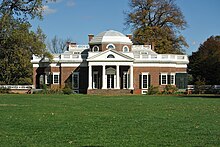Jeffersonian architecture
Jefferson's style was popular in the early American period at about the same time that the more mainstream Greek Revival architecture was also coming into vogue (1790s–1830s) with his assistance.
[3] Jefferson was also influenced by architect James Gibbs (1682–1754), and by French Neo-classical buildings, such as the Hôtel de Salm in Paris, when he served as Ambassador to France.
While the Jeffersonian style incorporates Palladian proportions and themes, it is at the same time unique to Jefferson's own personal sensibility and the materials available to him in early republican Virginia.
During his tenure in Europe, he had an opportunity to see some of the classical buildings with which he had become acquainted from his reading, as well as to discover the "modern" trends in French architecture that were then fashionable in Paris.
The room inside the dome was described by a visitor as "a noble and beautiful apartment," but it was rarely used—perhaps because it was hot in summer and cold in winter, or because it could only be reached by climbing a steep and narrow flight of stairs.
In 1803, President Jefferson appointed Benjamin Henry Latrobe as surveyor of public buildings in the United States, thus introducing Greek Revival architecture to the country for the first time.
Latrobe went on to design a number of important public buildings in Washington, D.C., and Philadelphia, including work on the United States Capitol and the Bank of Pennsylvania.






